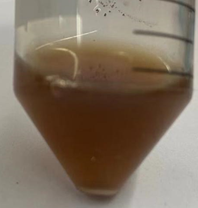Difference between revisions of "Part:BBa K1124011"
Minakuchi.T (Talk | contribs) (→Usage and Biology) |
Lydialiuyaqi (Talk | contribs) |
||
| Line 12: | Line 12: | ||
<span class='h3bb'>Sequence and Features</span> | <span class='h3bb'>Sequence and Features</span> | ||
<partinfo>BBa_K1124011 SequenceAndFeatures</partinfo> | <partinfo>BBa_K1124011 SequenceAndFeatures</partinfo> | ||
| + | |||
| + | =SMS_Shenzhen test this part in 2020 = | ||
| + | To examine the efficiency of HpaBC-WT, we transform pHpaBC-WT into a DH10b strain which is integrated with T7RNAP constitutive expression unit,which confirm the practicability of our fermentation system. | ||
| + | ==Deteals== | ||
| + | ===Experimental setup=== | ||
| + | - we first prepare DH10b[1], a strain that is integrated with T7RNAP constitutive expression unit, as component cell. <br> | ||
| + | - Then we transform HpaBC-WT and HpaBC-SMS to component cells, respectively.<br> | ||
| + | - The monoclonals are later overnight cultivated, and is then inoculated into fresh LB medium with a proportion of 1:200.<br> | ||
| + | - The samples are then cultivated for 48h, in 37℃, 220rpm. Samples are taken out, after the 48-hours-long cultivation, to measure for its L-dopa concentration.<br> | ||
| + | - The detailed description of measurement is illustrated below<br> | ||
| + | ===Results=== | ||
| + | We culture our strains overnight and find medium turning dark.<br> | ||
| + | [[File:T--SMS_Shenzhen--1.png|600px|thumb|center|overnight cultivated bacteria culture]]<br> | ||
| + | To explore the best substrate concentration for L-Dopa production, In this test, leveled concentrations of the substrate, tyrosine, (0mM, 0.03mM, 0.3mM, 1.5mM, 3mM, 4.5mM, 6mM, 9mM) are prepared. We then inoculate Bacteria in 7 mL LB medium and take for 500μL each time. They are taken at specific points: 30h, 39h, 42h, 50h. We use microplate reader to measure its absorbance under OD 400, and we determined the production of L-Dopa with standard curve of levodopa.<br> | ||
| + | [[File:T--SMS_Shenzhen--2.png|600px|thumb|center|Exploration on the best fit for substrate concentration--the process of L-dopa measurement]]<br> | ||
| + | The results are listed below.<br> | ||
| + | [[File:T--SMS_Shenzhen--3.png|600px|thumb|center|Modeling on the HpaBC enzymatic reaction]]<br> | ||
| + | The following column is about levodopa concentration in 3mM samples cultured for 42h.<br> | ||
| + | [[File:T--SMS_Shenzhen--4.png|600px|thumb|center|Changes before and after the codon optimization of HpaBC]]<br> | ||
| + | We can observe from the graph that, after codon optimization, HpaBC has presented higher biological activity. In the cultivation where the concentration of tyrosine is 3mM, after 42 hours of cultivation, the production of levodopa in HpaBC-WT is 0.88 mol/L; in the cultivation of HpaBC-SMS, the production is 1.12 mol/L. We thus chose HpaBC-SMS for the following experiments.<br> | ||
| + | |||
| + | |||
Latest revision as of 23:08, 27 October 2020
hpaBC (+RBS(natural))
Usage and Biology
This part consists of hpaB and hpaC genes, and is called hpaBC The products of these genes, HpaB and HpaC, together form an enzyme 4-hydroxyphenylacetate 3-hydroxylase. This enzyme hydroxylates L-tyrosine to produce L-DOPA in vivo.
It is known that hpaBC overexpression leads to increase of L-DOPA production in E. coli. We designed L-DOPA synthesis device(Part:BBa_K1124107) by combining this part and tyrosine synthesis device(Part:BBa_K1124106).
Sequence and Features
- 10COMPATIBLE WITH RFC[10]
- 12COMPATIBLE WITH RFC[12]
- 21INCOMPATIBLE WITH RFC[21]Illegal BglII site found at 97
- 23COMPATIBLE WITH RFC[23]
- 25COMPATIBLE WITH RFC[25]
- 1000INCOMPATIBLE WITH RFC[1000]Illegal SapI.rc site found at 1877
SMS_Shenzhen test this part in 2020
To examine the efficiency of HpaBC-WT, we transform pHpaBC-WT into a DH10b strain which is integrated with T7RNAP constitutive expression unit,which confirm the practicability of our fermentation system.
Deteals
Experimental setup
- we first prepare DH10b[1], a strain that is integrated with T7RNAP constitutive expression unit, as component cell.
- Then we transform HpaBC-WT and HpaBC-SMS to component cells, respectively.
- The monoclonals are later overnight cultivated, and is then inoculated into fresh LB medium with a proportion of 1:200.
- The samples are then cultivated for 48h, in 37℃, 220rpm. Samples are taken out, after the 48-hours-long cultivation, to measure for its L-dopa concentration.
- The detailed description of measurement is illustrated below
Results
We culture our strains overnight and find medium turning dark.
To explore the best substrate concentration for L-Dopa production, In this test, leveled concentrations of the substrate, tyrosine, (0mM, 0.03mM, 0.3mM, 1.5mM, 3mM, 4.5mM, 6mM, 9mM) are prepared. We then inoculate Bacteria in 7 mL LB medium and take for 500μL each time. They are taken at specific points: 30h, 39h, 42h, 50h. We use microplate reader to measure its absorbance under OD 400, and we determined the production of L-Dopa with standard curve of levodopa.
The results are listed below.
The following column is about levodopa concentration in 3mM samples cultured for 42h.
We can observe from the graph that, after codon optimization, HpaBC has presented higher biological activity. In the cultivation where the concentration of tyrosine is 3mM, after 42 hours of cultivation, the production of levodopa in HpaBC-WT is 0.88 mol/L; in the cultivation of HpaBC-SMS, the production is 1.12 mol/L. We thus chose HpaBC-SMS for the following experiments.




